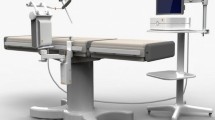Abstract
Background: The triangle paralaxis method for camera control in teleoperating is presented.
Methods: For orientation in the 3D space of the corporic cavity there are three points necessary for the creation of the paralaxis triangle. This triangle is then imagined and compared with topography during surgery. The first and second points are created in one's mind at the locus of the entry of the instruments into the viewing field of the camera. The third apex of the triangle is the area of dissection—the point in which the instruments converge. The fourth point to be viewed determines the course of dissection. Triangle paralaxis may be applied in dissection with only one instrument as well as in the zooming technique, closely viewing a part of the dissecting instrument.
Results: Using this technique a 7.78% rate of conversion and 2.15% rate of reoperation could be achieved in 334 evaluated laparoscopic cholecystectomies performed in a small public hospital.
Conclusions: Triangle paralaxis seems to be a simple method for ensuring an optimal camera view during laparoscopic surgery.
Similar content being viewed by others
References
Adamer K (1995) Wie sinnvoll ist die laparoskopische Cholezystectomie bei akuter Cholzystitis. Wien Klin Wochenschr 107: 525
Deziel DJ, Millikan KW, Economon SG, Doolas A, Ko S-T, Airan MC (1993) Complications of laparoscopic cholecystectomy: a national survey of 4,292 hospitals and an analysis of 77,604 cases. Am J Surg 165: 9
Estour E (1992) Essai de cartographie parietale abdominale en coeliochirurgie. J Coelio-Chir 2: 3
Gitter Th, Wayand W, Woistschläger R (1995) AMIC-Arbeitsgemeinschaft für Minimal invasive chirurgie Der Stand der laparoskopischen Cholezystektomie in Österreich. Wien Klin Wochenschr 107: 61
Malms J (1995) Das Weltbild prägt die Karten, und die Karten prägen das Weltbild. P M Leser 8: 86
Manger Th, Fahlke J, Settmacher U, Zanow J, Lippert H (1994) Komplikationen bei 1000 laparoskopischen Eingriffen. Minimal Invasive Chir 2: 64
Manneberg G, Witt H, Slezak P (1995) Quantitative endoscopic classification of esophagitis by means of computerized image processing. Part 1: theoretical background. Hepatogastroenterology 42: 135
Mueglitz J, Kunad G, Dautzenberg P, Neisius B, Trapp R (1993) Kinematic problems of manipulators for minimal invasive surgery. End Surg 1: 160
Pier A, Thevisse P, Eikel M, Götz F (1994) Laparoskopische Nahtund Knüpftechniken. Chirurg 65: 473
Rininsland HH (1993) Basics of robotics and manipulators in endoscopic surgery. End Surg 1: 154
Schmidt P, Ezer P, Antal L (1995) Complications of laparoscopic cholecystectomy—an analysis of 2,100 operations. Acta Chir Austriaca 27: 161
Siewert JR, Feussner H, Scheer MA, Brune IB (1993) Fehler und Gefahren der laparoskopischen Cholecystektomie. Chirurg 64: 221
Slim K, Pezet D, Stencl J Jr, Lechner C, Le Roux S, Lointier P, Chipponi J (1995) Laparoscopic cholecystectomy: An original three-trocar technique. World J Surg 19: 394
Troidl H, Spangenberger W, Dietrich A, Neugebauer E (1991) Laparoskopische cholecystektomie. Erste erfarungen und Ergebnisse bei 300 Operationen: Eine prospektive beobachtungsstudie. Chirurg 62: 257
Woisetschläger R, Wayand W (1995) Eingeladener Kommentar: Komplikationen nach endoskopischer Cholzystektomie—eine Analyse von 2,100 Operationen. Acta Chir Austriaca 27: 165
Z'graggen K, Metzger A, Birrer S, Kleiber C (1995) Die laparoskopische Cholecystektomie als Standardtherapie bei der akuten Cholecystitis. Eine prospektive Studie. Chirurg 66: 366
Author information
Authors and Affiliations
Rights and permissions
About this article
Cite this article
Danis, J. Theoretical basis for camera control in teleoperating. Surg Endosc 10, 804–808 (1996). https://doi.org/10.1007/BF00189538
Issue Date:
DOI: https://doi.org/10.1007/BF00189538




